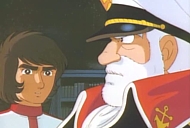
Space Battleship Yamato 5: Final Yamato
I love a good Garbage Burger. For those of you unaware, the chain restaurant Max & Erma's is known for this feast on a bun, which features a big patty covered with three kinds of cheese, bacon, marinara sauce, guacamole, and more. It's truly the kitchen sink. Of course, there are some problems with eating one of these things. First off, it's so massive that getting it off the plate is a problem, and stuff tends to spill onto nearby surfaces (with a special affection for new shirts). But perhaps more importantly, most of us are going to order it minus a couple of items. For me, I always skip the tomatoes and pickles -- tomatoes I can survive, but pickles are a dealbreaker. If you have to eat it just as is, it's not quite the wonder it would be otherwise.
Final Yamato, the fifth film in the franchise and the last one for over 26 years, is the Garbage Burger of anime. Is there anything you've ever wanted to see in a Yamato film? It's in there. Gigantic space battles, operatic deaths, characters back from the dead, you name it. Knowing this would be the last film in the series, the movie is packed with stuff, so much so that it holds the record for the longest animated film ever. It's also far more effective than the numbing stupor of Farewell Space Battleship Yamato, which was the original climax to the whole series until it was clear fans wanted more. But just like the original Garbage Burger, there are some things in Final Yamato that are hard to stomach. While the creators of the film eventually decided to take off a couple of toppings -- more about that in a minute -- it's still overloaded and yet missing a vital ingredient. Still, the whole thing goes down pretty well.
Final Yamato begins with our narrator telling us how our world got its water...apparently, it was due to the planet Aquarius passing near to Earth. The Yamato crew, under the command of long-time lead Kodai Susumu, discover this havoc-reaking planet as they investigate the remains of the world colonized by their former enemy Desslar. It's not due to come around to Earth again for another 6,000 years...nothing to worry about, right? Wrong. The remnants of the Dinguil, a race whose planet was destroyed by Aquarius, decide that they are going to do the same thing to Earth and then, when everyone's evacuated, take over. In the meantime, Kodai is shaken to the core by the loss of many crew members in a largely unsuccessful rescue attempt on the Dinguil home planet, and when they finally make it back to Earth, he resigns his command. As it turns out, it's not so bad that he's downgraded to the combat chief, for a friend long thought dead is returning...and the crew of the Yamato are going to need all their collective experience to beat the onslaught of the Dinguil.
Final Yamato does a number of things well. The score is impressive, and while the films have always enjoyed good soundtracks (minus an annoying ballad here and there), this one is excellent. The contributions of newcomer Kentaro Haneda, who went on to score Macross, are not easily dismissed, fitting well alongside the work of longtime series composer Hiroshi Miyagawa. The animation is easily the best of the entire series, and though it isn't consistent throughout, the detail in many scenes is strong by standards of its day. For such a long movie, the pacing is reasonably crisp. It also features some interesting design work; a few sequences and key structures look like they were influenced by The Black Hole, which while not the greatest sci-fi film of the 1980s has some great conceptual art. Many characters who hadn't died by this point have at least cameos here, so I'd be surprised if somebody went away disappointed that they didn't get a last glimpse at an old favorite.
Plot-wise, though, Final Yamato drops the ball. Coming off of Be Forever Yamato with its surprisingly strong villains, the bad guys here are an afterthought...that vital ingredient I mentioned before. They have no real personalities whatsoever, just a one-track-mind about taking over Earth. Multiplying that problem are the interconnected issues of amazing coincidences and predictable poignancy. Need the guy who's been growing into the captain's chair for the entire series suddenly to go all immature? Sure. Plot require a dead captain resurrected? Can do. Children used for nothing more than added emotional resonance? Check. When the crew is incapacitated, can the Yamato make it back home to Earth by herself? Why not!! Talk about your contrivances.
Many of these issues might be explained by the massive cutting that had to be done to the script, which in its original storyboarded form was well over 3.5 hours long. But still, I was frustrated by all the stuff I was being forced to swallow in order to enjoy the story. That said, director Yoshinobu Nishizaki really did cut away the fat to try and make this the best movie possible, as witnessed by the film's alternate ending. Originally, the film ended with the marriage of Kodai and long-suffering fiancé Yuki, followed by said relationship's consummation and a bit of blather from the spirit of the planet Aquarius. The love scene itself was very tame, definitely falling into the PG category, but the whole thing was unnecessary and distracted from the film's real ending, and Nishizaki knew it. While the film first premiered with this closing, it has since changed, and the new version (with some additional footage elsewhere) is what most people see for the better.
There's a reason that finishing off the Kodai/Yuki story wasn't necessary, and that's what struck me as I was watching the ending of Final Yamato. At this point in the game, Yamato is no longer science fiction or even highly melodramatic space opera. Yamato became modern mythology. But unlike Joseph Campbell and the western mythological narrative seen in Star Wars, this harkens back to ancient (and certainly more far-Eastern) mythology. It's not about the individual but about the collective, group history as seen through the lens of the battle cruiser that has saved Earth countless times. Mythology is allowed to get away with resetting the narrative and forsaking continuity, and that's because the story isn't in the details so much as it is in the overarching themes of destiny, love, sacrifice, and honor. Kodai and his crew are all part of the overarching tale of the Yamato itself, important not because they are unique individuals but because they serve the ship faithfully as a team. By the last reel, even though it's not spelled out, it's clear that there's a reason why the battleship was given the country's ancient name...because it is, indeed, Japan. If you've gotten through the whole blooming thing and don't get a little choked up when the credits roll, you've missed out.
This isn't the best Yamato voyage, necessarily. It has significant problems like the others. But as a conclusion to the whole affair, it's still on par with the third and fourth films. For those who've gone on this adventure, I think it's worthwhile, getting past the datedness of it all. As a fitting ending to the ten years of stories that came before, it's about the best you could hope for. And as 2009 ended with the film Space Cruiser Yamato: Rebirth, if you still crave more Yamato, guess what? As it turns out, it's not quite so final after all.
Final Yamato -- violence -- B

